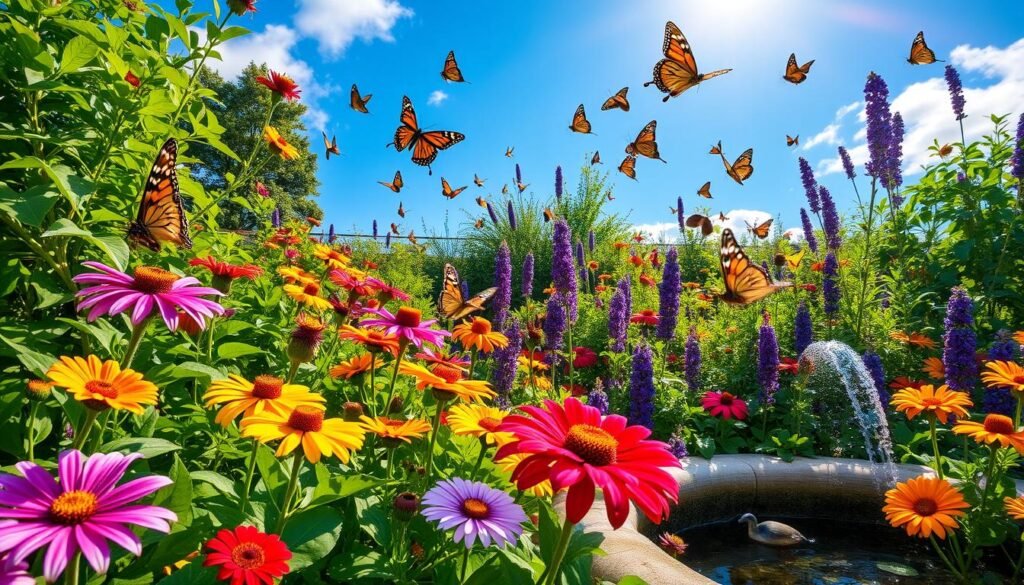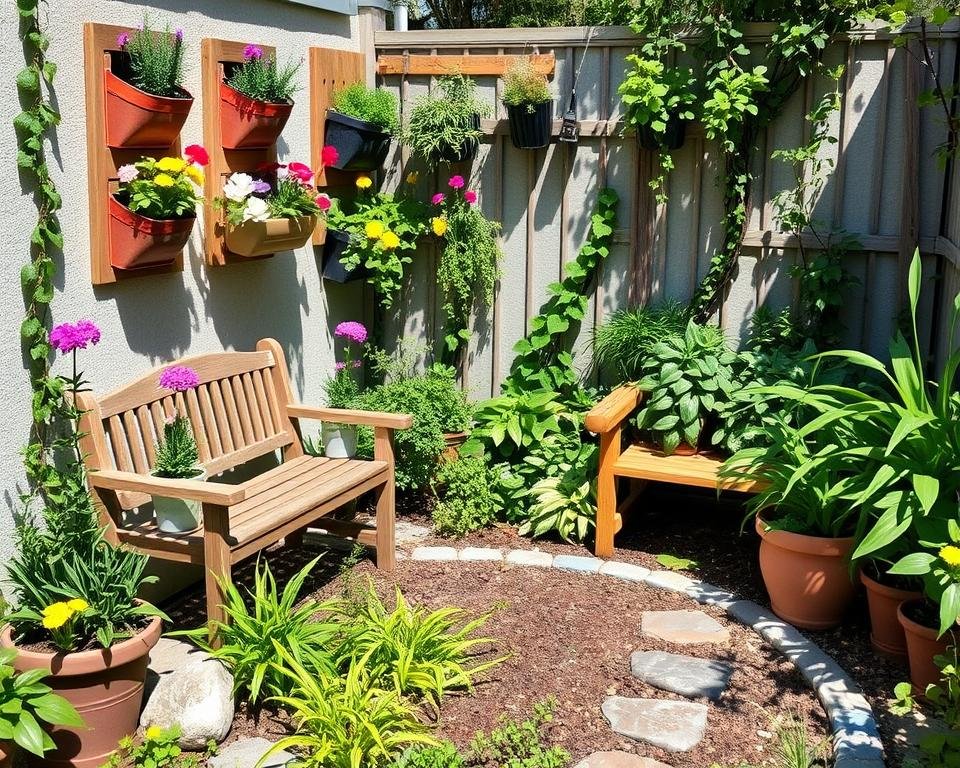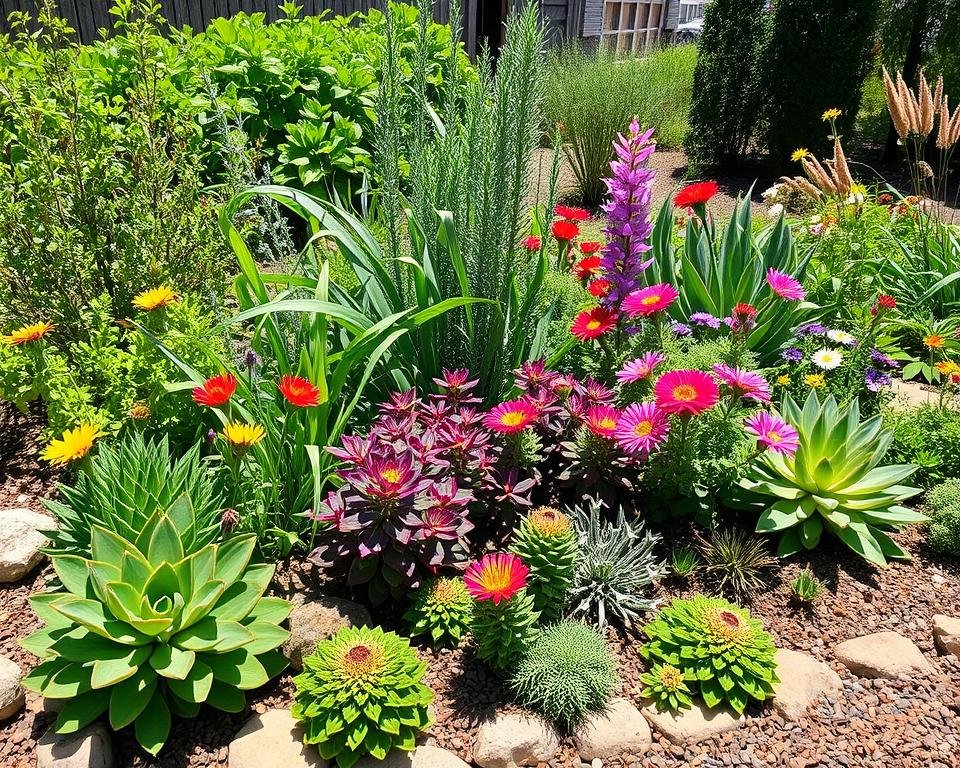Ever thought of turning your garden into a vibrant, pollinator-friendly haven? Pollinators like bees, butterflies, and hummingbirds are essential for a healthy ecosystem. Yet, their numbers are dwindling rapidly. But, with the right approach, you can create a sanctuary for them and enjoy their beauty in your garden.
This guide will show you how to attract pollinators to your garden. You’ll learn about choosing the best nectar-rich plants and providing essential resources. By doing so, you’ll create a sustainable landscape that meets the diverse needs of these remarkable creatures. Get ready to transform your garden into a pollinator paradise and contribute to their conservation.
Understanding the Importance of Pollinators
Pollinators are the unsung heroes of our natural world, playing a crucial role in maintaining a healthy ecosystem. These remarkable creatures, including bees, butterflies, and hummingbirds, are responsible for the pollination of a vast majority of the plants we rely on for food and sustenance.
The Role of Pollinators in a Healthy Ecosystem
Pollinators are the driving force behind the reproduction of many plant species. By transferring pollen from one plant to another, they enable the production of fruits and seeds. These are essential for the continued growth and diversity of our plant life. This intricate web of interdependence is what keeps our ecosystem thriving and balanced.
Why Pollinators Need Our Help
- Sadly, pollinator decline has become a pressing global concern, with populations of bees, butterflies, and other pollinators dwindling at an alarming rate.
- Factors such as habitat loss, pesticide use, and climate change have all contributed to this decline, threatening the delicate pollinator conservation efforts.
- By taking action to support and protect these vital creatures, we can ensure the continued health and vitality of our healthy ecosystem, which benefits us all.
Recognizing the critical importance of pollinators is the first step towards safeguarding their future and preserving the delicate balance of our natural world. Join us in our efforts to pollinator conservation and help protect the pollinators that keep our ecosystem thriving.
Creating a Pollinator-Friendly Garden
Turning your outdoor area into a haven for pollinators is a rewarding journey. It benefits both your garden and the local ecosystem. By focusing on the right plants, water sources, and shelter, you can create a sustainable garden. This garden will attract a variety of bees, butterflies, and other pollinators.
The core of a pollinator-friendly garden lies in the plants you choose. Select native, nectar-rich flowers that meet local pollinators’ needs. These plants offer food, shelter, and nesting sites. Include a mix of blooms that flower at different times to ensure a steady supply of nectar and pollen.
Providing water sources is also key for pollinators. A bird bath, shallow dish, or even a damp sponge can be a hydration station. Make sure to keep the water clean and replenished for your pollinators’ health.
Pollinators need sheltered areas for nesting and overwintering. Add features like log piles, brush piles, and undisturbed soil areas. These provide safe havens for solitary bees and other beneficial insects. They also enhance your garden’s diversity and contribute to sustainable landscaping.
By adopting pollinator-friendly gardening and using native plants, you can transform your space. It becomes a vibrant, eco-friendly haven that supports our natural world’s balance. Take pride in being a land steward and enjoy the beauty of a pollinator-friendly garden.

Tips on Planting Flowers and Creating Habitats That Attract Bees, Butterflies, and Other Pollinators
Creating a pollinator-friendly garden is crucial for the health and diversity of our ecosystems. By selecting nectar-rich flowers and providing water, you can turn your outdoor space into a haven. This will attract bees, butterflies, and other beneficial insects.
Choosing the Right Nectar-Rich Plants
To attract a variety of pollinators, choose nectar plants that bloom all season. Mix annuals and perennials for a continuous nectar and pollen supply. For a butterfly garden, consider these plants:
- Coneflowers
- Zinnias
- Lantana
- Cosmos
- Lavender
Providing Water Sources for Pollinators
Pollinators need water to stay hydrated. Install a shallow birdbath, dripping faucet, or a water dish with pebbles. These will provide a safe hydration source for your pollinator friends.
By following these tips, you can create a bee-friendly and butterfly-friendly oasis. This will support the essential pollinators in your local ecosystem.

Bee-Friendly Flowers for Your Garden
Creating a bee-friendly garden is simpler than you might imagine. By choosing a mix of annual and perennial flowers, you can build a vibrant, sustainable space. This space will attract bees and other pollinators, enhancing your garden’s beauty and ecological value.
Annual Flowers That Attract Bees
Sunflowers, cosmos, zinnias, and marigolds are annuals that bees adore. These flowers offer a rich source of nectar and pollen, crucial for pollinators. Plant them in groups to boost their appeal and create a stunning visual effect.
Perennial Flowers for Pollinators
Lavender, echinacea, and bee balm are perennial favorites for bees and butterflies. These plants are resilient, returning year after year. They provide a steady food supply for pollinators, making them key components of a long-lasting garden.
FAQ
What are the key elements to consider when creating a pollinator-friendly garden?
Creating a pollinator-friendly garden involves several key elements. First, choose a variety of nectar-rich plants. Next, ensure there are water sources available. Also, include shelter and nesting sites for pollinators. Lastly, avoid using harmful pesticides.
Why are pollinators important for a healthy ecosystem?
Pollinators, like bees and butterflies, are crucial for a healthy ecosystem. They help plants reproduce, supporting a wide range of organisms. Without them, biodiversity and ecosystem productivity would decline significantly.
What are some of the best flowers to attract bees to my garden?
For attracting bees, include sunflowers, lavender, cosmos, zinnias, and echinacea in your garden. These flowers offer nectar and pollen, which bees find irresistible.
How can I provide water sources for pollinators in my garden?
To provide water for pollinators, consider installing a shallow birdbath or a small pond. Alternatively, place rocks or pebbles in a shallow dish with water. This allows pollinators to safely access the water.
What are some common native wildflowers that attract butterflies?
Native wildflowers like milkweed, coneflowers, butterfly bush, and Joe-Pye weed attract butterflies. These plants provide nectar and serve as host plants for butterfly larvae. They offer a complete habitat for these pollinators.

